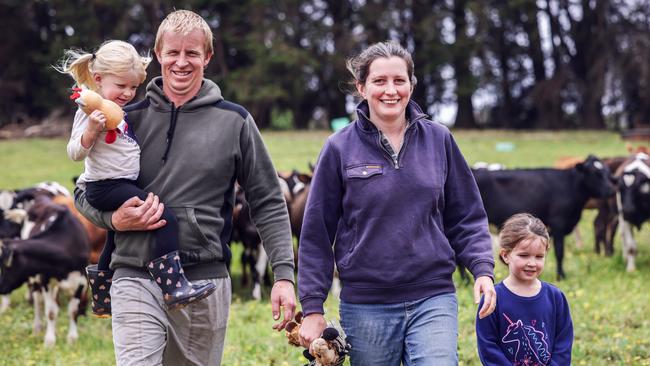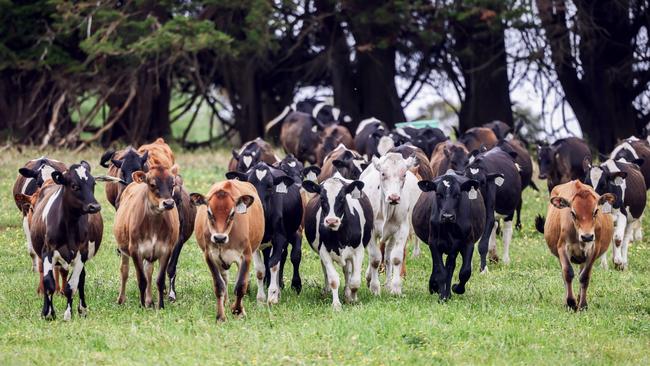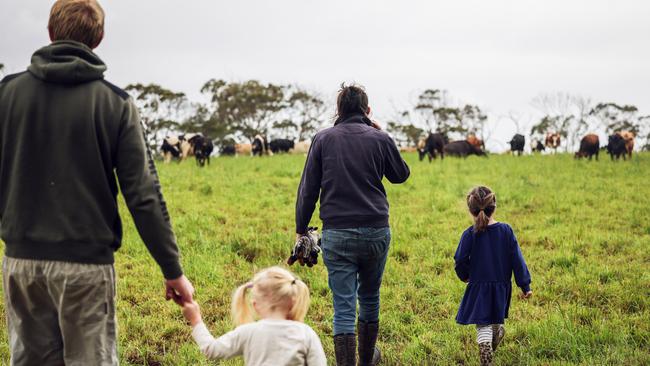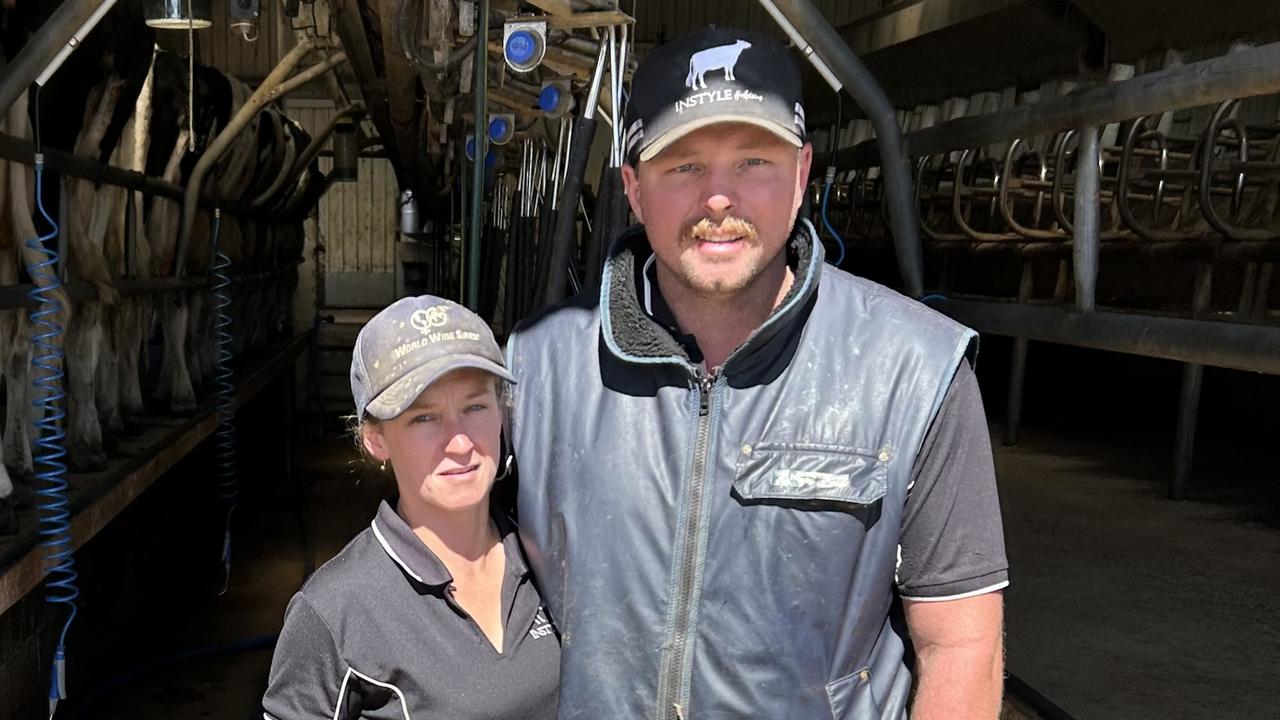Rachel and Dale McLean avoid dairy rout from southwest Victoria green drought
The green drought hit southwest Victorian dairy farmers in 2024, but Rachel and Dale McLean say their year in dairy turned out a little differently.

Setting budgets, maximising grass and achieving a consistent milk price for the season, help Rachel and Dale McLean stick to their goals.
The couple operate a 190-cow dairy herd at Gorae, about 15 minutes out of Portland in Victoria’s far southwest, all on lease land.
“We took over the lease of the farm five years ago,” Rachel said.
“Dale is a second-generation dairy farmer, while I’m a sixth generation farmer, but in apple orchards, not dairy farming.
“We are 100 per cent dairy – we prefer to concentrate all our attention on the cows and the replacement heifers and calves.”
Rachel said the recent leasing of an outblock not far from their main Gorae property has made grass management easier.
“We lease 440 acres (178ha) in total — 340 acres (138ha) on the dairy platform, and another 100 acre (40ha) out-block which we run our heifers on.
“The dairy platform is as large as it can get as it is currently quite landlocked between other farming enterprises.
“However, we have recently taken over the lease of the outblock which is only short term but has made a huge difference to how we can manage and maximise the grass on the dairy platform.
“We have one employee, and the rest of the time, it is just the two of us on the farm.”

SILVER LINING
While green drought was a scourge for many primary producers across southwest Victoria this year, some pockets such as the Portland hinterland and Heytesbury settlement area fared better than most.
“Although it has been a very dry winter and spring, we have benefited from the lower rainfall over winter,” Dale said.
“We managed to graze all our paddocks with no pugging which is something usually cannot do during the wetter months.
“Last year was very tough for our farm, we had a failed spring where the farm transitioned from too wet to too dry very quickly and our silage and hay yield for the year was half of our usual harvest.”
The Portland has an average rainfall of about 800mm, which falls usually between April to November, with heaviest rainfalls in September.
Rachel said July was previously the region’s wettest month but seasonal changes have required some adjustment when it comes to harvest and pasture management.
“Our farm is located so close to the coastline, we are lucky to experience quite mild summers, but very wet winters,” she said.
“We have been very lucky this year to have had a very good season.”

ON SOLID GROUND
Part of this year’s reasonably successful season for the McLeans has been drier conditions favouring their flat, clay loam pastures.
The Gorae property has 54 paddocks on the dairy platform, mostly 2.5ha in size with some larger paddocks further away from the dairy.
“We rotationally graze all year around, aiming for a 70-plus day rotation in winter, and closer to a 25-day rotation in spring,” Rachel said.
“Our farm is relatively flat, with around 80 acres low lying flats that can go under water in winter.
“We have mostly a clay loam soil type, with the low-lying flats having a black, swampy soil.”
This year, the McLeans have been using PastureSmart, a satellite pasture yield estimator to help with feed allocation, which has improved their pasture utilisation.
“Most of our pastures are a mix of rye-grass, chicory and clover, with mostly Italian or perennial rye-grass used,” Rachel said.
“We have three paddocks of cocksfoot that we have planted on our sandier soils which we are still trialling at this stage to see if we continue to use cocksfoot or not.
“Over the last two years, we have been using multispecies winter crops to carry the herd through winter and we have had good success off these.”

COST OF PRODUCTION
In 2023, the biggest cost of the Gorae farm was supplement feed, with this year’s costs of production easing for the McLeans.
“We finished last year with a cost of production of $8.01 per kilogram milk solids, which is higher than we are comfortable with, but was expected given the season we were dealt,” Rachel said.
“Our cost of production will be reduced substantially this year. Our production has increased and decreased over the five years we have been here, as we work to find the perfect stocking rate for the land.
“We have reached a peak of 240 cows, but found the farm couldn’t handle to stock numbers during winter. We are now aiming to get the most out of our 190 cows, with as much homegrown feed as possible.
“We set our budgets each year before calving begins, and finalise our cashflows in June once the milk price has been announced for the year.
“Last year we purchased most of our hay during spring, once we realised our harvest wasn’t going to be as high as we had hoped for. This year, we will have enough to get us through without having to source any other feed.”
The McLeans join the milking herd with conventional artificial insemination for six weeks, and then mop up with beef bulls, usually Hereford or Murray Grey for four weeks.
“Our heifers are joined to a fixed time mating for one joining only then the beef bulls are put with them for six weeks,” Rachel said.
“Fertility is something that we have struggled since we first put the herd together five years ago, but gradually we have cut the calving season back from six months, to the current 10 weeks, and last year averaged 78 per cent in calf rate for the AI.”

SOUTH BY SOUTHWEST
Adhering to co-operative principles, the McLeans are part of the South West Dairy Limited group, which offers a flat milk price – the same milk price every month of the year – so discounting of spring milk is avoided.
SWDL offers a 1:1 price for butterfat and protein, no volume charge and all step-ups are paid across all milk supplied in that season.
Rachel is the field officer for SWDL and the McLeans have been supplying the group since 2022, when they moved across due to the difference in income because of the spring milk price.
“We have stayed with them because we are lucky enough to have a company of farmers who farm the same way as we do, dry off completely and then peak production during spring, so we are surrounded by farmers who can help mentor and advise us as we go,” she said.
The McLeans have averaged 6500 litres per cow a year, or 480kg milk solids per cow which has been consistent over the past few years.
While farmgate milk prices have generated headlines this season, Rachel said their aim is making the best of market conditions.
“As farmers, we would always like a higher milk price, however we are comfortable that we can still make the most of the $8 milk price,” Rachel said.
“We, as an industry, cannot afford to not be competitive in our pricing post-production or we risk losing not only our domestic market as people look to cut costs everywhere they can, but also our export market which is always threatened by cheaper milk if its available.”
The McLeans are concentrating on improving profitability so they’re in a position to buy a farm when the opportunity arises.
“We completed the ‘Our Farm Our Plan’ course together three years ago now and regularly refer back to our plans to remind ourselves where we are aiming for and why,” Rachel said.
“A lot of the goals we set for ourselves during the initial course we have now completed, but we complete an updated plan each year which we use as a guide for our day-to-day planning.”





